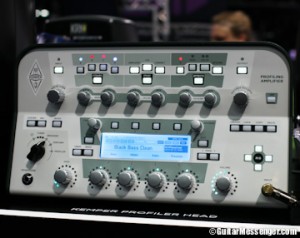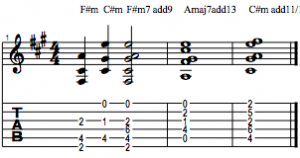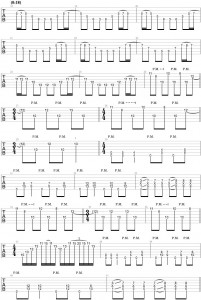INTRODUCTION
 Playing ‘outside’ is a term synonymous with jazz rock/fusion guitar players. Within traditional forms of jazz this term is replaced by ‘using chromaticism.’ In blues, country, and folk forms it’s called ‘blue notes.’ In everything else it’s considered ‘the wrong notes.’
Playing ‘outside’ is a term synonymous with jazz rock/fusion guitar players. Within traditional forms of jazz this term is replaced by ‘using chromaticism.’ In blues, country, and folk forms it’s called ‘blue notes.’ In everything else it’s considered ‘the wrong notes.’
In all forms, however, the common goal is to play a note that clashes against the background harmony in order to create tension and thus reinforce resolution when it arrives.
By definition, this could mean anything that is not heard in the chord – even notes that we consider as extensions, derived from chord scales. We must therefore ascertain what it means to use these ‘outside notes’ in order to understand how to effectively employ them as devices to strengthen tension and colour in the music we create.
This lesson will introduce ideas of utilising dissonances and playing ‘outside.’ It requires that you have a good knowledge of the construction on extended chord types, modes of the major scale, and some knowledge of the modes of harmonic and melodic minor.
Scales will be referred to using a numerical system that represents major scale degrees. For example, a normal major scale would be seen as 1 2 3 4 5 6 7. A minor scale would be seen as 1 2 b3 4 5 b6 b7. A phrygian dominant scale would be seen as 1 b2 3 4 5 b6 b7, etc. By ensuring you are familiar with this system means that you will be able to apply any of the concepts herein in any key.
BLUES
Let us first take the blues. As we know, the blues is built from employing a I IV V progression using dominant chords. A dominant chord is constructed by playing a Root (R), major 3rd (3), perfect 5th (5), and flattened 7th (b7) of a major scale simultaneously. This denotes that we would use these chord tones to create consonant melodies.
What it doesn’t tell you is where this chord is being built from. For most, a dominant blues I chord is built from the 5th degree of the major scale, also known as the mixolydian mode. The formula for this scale gives us a rather consonant 1 2 3 4 5 6 b7. However, a dominant chord can be built from many other parent scales. It appears in various modes of the harmonic minor, melodic minor and harmonic major scales.
It is not common practice to write blues music with these scales nor would it be aurally familiar or successful in creating an ‘authentic’ blues. The reason I mention this is to show that our understanding of what sounds consonant and what sounds dissonant is not dependent on theory (although many would have you believe that) – it is instead through the culmination of our aural experiences. Proof of this is plainly seen in blues melodies/improvisations through the inclusion of the flattened 3rd to major 3rd shift (or in the case of minor blues, the inclusion of the b5) which is fundamental to the characteristic sound of the style.
Saying that every note other than chord tones is ‘outside’ is not true due to our aural conditioning. For instance, the notes of the mixolydian mode heard against a dominant 7 chord still sound consonant. So to play ‘outside’ you must first have a good understanding of what sounds ‘inside,’ which is only discernible by taking into account the harmonic background and the stylistic context in which the piece exists.
Here is a list of all 12 pitches and their functions within a dominant 7 blues (from Mixolydian). The inside notes represent the chord tones from a dominant 7. The consonant extensions are the degrees that can be played without sounding ‘outside.’ The dissonances are the notes we should employ to create tension and thus play ‘outside.’
- Inside Notes (Chord Tones)
- 1, 3, 5, b7
- Consonant Extensions
- 2, 4, 6
- Dissonances
- b2, b3, b5, b6, 7
*The b3 can also function as a consonant extension in the blues due to our aural conditioning.
Care must be taken to understand that this scenario applies only to dominant 7 traditional blues style settings. For instance, a dominant 7 chord built from the 5th degree of the harmonic minor scale (Phrygian Dominant 1, b2, 3, 4, 5, b6, b7) may look more like this:
- Inside Notes (Chord Tones)
- 1, 3, 5, b7
- Consonant Extensions
- b2, 4, b6
- Dissonances
- 2, b3, b5, 6, 7
Notice how the function of the 2nd degree has now changed even though the chord type is the same. Here is the same dominant chord built from the 5th degree of the melodic minor (mixolydian b6 – 1, 2, 3, 4, 5, b6, b7) instead:
- Inside Notes (Chord Tones)
- 1, 3, 5, b7
- Consonant Extensions
- 2, 4, b6
- Dissonances
- b2, b3, b5, 6, 7
Every chord type in every situation will have varying note functions so you must make yourself familiar with the construction of all chord types and their relevant extensions/dissonances.
We have mainly talked about chords individually and while playing ‘outside’ over a one-chord vamp is a great place to start, we must consider the implications of playing ‘outside’ over a progression of chords. Mapping out every conceivable chord progression is a near impossible task, but we will cover playing ‘outside’ over common chord progressions. The next step is to talk about where to apply these dissonances within your improvisations.
RHYTHM
Rhythm is the key to effective use of dissonances. First and foremost players must remember that the purpose of using dissonances in this way is to create and release tension. To do this you must focus on accent points.
To begin with, try playing over a four or eight bar vamp, focusing on playing ‘outside’ during particular ‘spaces.’ This means choosing amounts of beats/time that you will use your outside notes to build tension. Here are some suggestions:
- Last two beats of bar four
- All of bar four
- Last two beats of bar two and four
- All of bar two and four
Each will give you a different sound. Using this exercise will help you learn to feel where you can place your ideas. Think of some more places where you could employ outside playing over larger structures of 8, 16 or 32 bars or even odd times like 5, 7, 9, 11, etc. As we go on, you will realize that you don’t have to always resolve an outside line – in fact, sometimes it’s pertinent not to – however, to begin make sure you do.
SUMMARY
- Familiarise yourself with all the scales/modes you can and their relevant chord scales.
- Think about ‘reinforcing inside,’ as opposed to ‘playing outside.’
- Try different rhythmic placing to see what feels right.
- To begin with always resolve back to a chord tone once you have finished your outside phrase (we will look at non-resolving outside lines later).
- Think about sound and effect – your outside ideas will be of no use if they don’t sound good on their own. Make sure you try to incorporate the same level of melodic detail you would in your normal lines (i.e. don’t just hammer the wrong notes!).
- Play with attitude to sound like you mean to play the notes!
Now…. on to the notes!
SIDESTEPPING
Sidestepping is the easiest way to get into outside playing. The basic principle is that by default on the guitar, you can take the shape that you would normal play in and move it up or down a fret to give you access to the dissonances. To begin with, try moving a minor pentatonic this way. Here are some examples over A minor:
Example 1
EX1

Example 2
Ex2

Example 3
Ex3

Example 4
You can also try to move motifs, too! This example uses a Joe Bonamassa/Eric Johnson style pentatonic sequence in groupings of five. Using odd groupings makes the outside ideas stand out even more as the resolution starts to happen before the third bar in this instance.
Ex5

Example 5
This example employs a string-skipping idea based around A dorian. The outside shift comes in one the third beat of the second bar. The shape from the second beat is shifted up a semitone and kept there for two beats, while continuing the rising melodic fragment on the first string. The line resolves back to an A in the following bar by means of semitone approach.
Ex4

Example 6
You can also experiment staying outside for longer by continuing the motif shifts. This example again employs a similar string-skipping sequence, but it is much more rhythmically fragmented and has a Jimmy Herring feel to it.
Ex6

Improvisation
Here is a full backing track and improvisation from me in A minor, using only sidestepping ideas working from A minor pentatonic and A dorian. Try incorporating some of these ideas into your playing and then turn them into your own. At this point, I would urge that you seek out some key exponents of this style to get the sound in your head.
Full Track
Backing Track
Keep your phrasing strong and always follow through with your choices. While sidestepping is quite a ‘shot in the dark’ approach, it is a great way to get the sound and phrasing into your head before refining what you are playing. In the next lesson, we will explore how to be more accurate with outside playing by using selected scales to produce varying degrees of outside tensions.
















